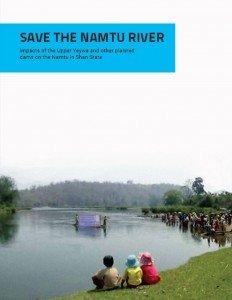Save The Namtu River
By Shan Human Rights Foundation, Shan Sapawa Environmental and Shan State Farmers' Network • March 30, 2016 In January 2016, Burma’s state media reported that Naypyidaw was proceeding with four new hydropower dams on the Namtu (Myitnge or Dokhtawaddy) River, three of which are in conflict areas of Shan State. These new dams, together with the existing Yeywa dam, will form a cascade blocking half the entire length of the river.
In January 2016, Burma’s state media reported that Naypyidaw was proceeding with four new hydropower dams on the Namtu (Myitnge or Dokhtawaddy) River, three of which are in conflict areas of Shan State. These new dams, together with the existing Yeywa dam, will form a cascade blocking half the entire length of the river.
The most advanced of the new dams is the Upper Yeywa Dam in Nawngkhio township, started by Burma’s military regime in 2008, and slated for completion in 2018. The planned reservoir will stretch for over 60 kilometers, entirely submerging a large Shan village of nearly 500 residents, called Ta Long, and possibly submerging part of Hsipaw town.
Ta Long (meaning “large harbor”) is a prosperous community, renowned in northern Shan State for its organic oranges and pomelos, grown along the riverbank. Ancient stupas in the village are hundreds of years old. Ta
Long villagers were neither informed nor consulted before the dam began. An Environment and Social Impact Assessment (ESIA) was carried out for the dam only in 2014, six years after the dam had begun. During the ESIA, the villagers statedclearly that they were not willing to move. Despite this, dam-building has continued, with funding from China, and with the involvement of Chinese, Japanese, German and Swiss companies. A diversion tunnel has been completed, and construction of the main dam wall was beginning in early 2016.
Download the full report in English here.
အစီရင္ခံစာ ျမန္မာဘာသာကုိ ဤေနရာတြင္ ရယူႏိုင္သည္။
အစီရင္ခံစာ ရွမ္းဘာသာကုိ ဤေနရာတြင္ ရယူႏိုင္သည္။
Tags: Business and Human Rights, Crimes against humanity, Human Rights, Human Rights Violations, Natural Resources, Shan Human Rights Foundation, Shan Sapawa Environmental Organisation, Shan State Farmers NetworkThis post is in: ASEAN, Business and Human Rights, Crimes Against Humanity, Displacement, Economy, Environmental and Economic Justice, Ethnic Nationalities, Health, Human Rights, Law, Military Regime
Related PostsKaren State September 2016 Conflict: The Real Motivations Behind Renewed War
Burma Army’s actions in Karen State threaten to expand fighting, endangering peace process and displaced people’s return
Ann Din Coal Power Plant: Local Movement and Action to Preserve and Protect Natural Resources and Land: Mon IDP Report Case Study #4
New film: Shan State’s unique “Thousand Islands” under threat from Salween dam plans
EU Must Continue UN General Assembly Resolution on Burma









 All posts
All posts